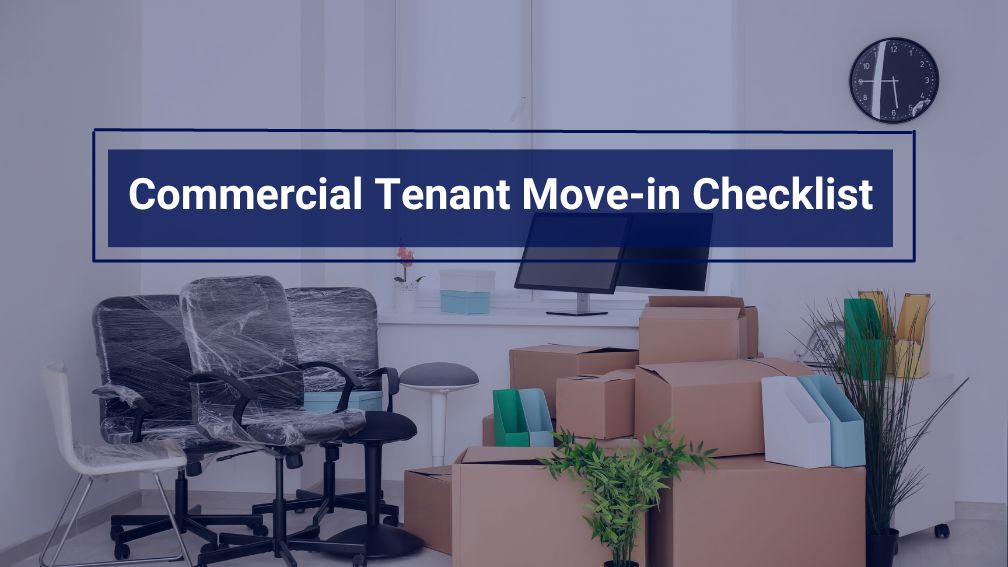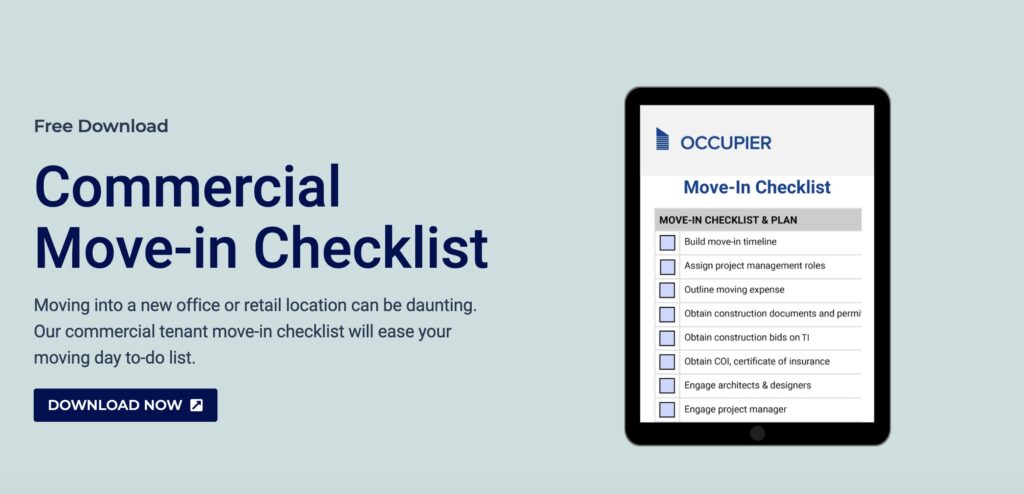Commercial Tenant Move-in Checklist
Last Updated on May 2, 2023 by Morgan Beard
As the head of real estate, moving your business to a new location can be a daunting task. It’s normal to feel overwhelmed and wonder where to begin. Our commercial tenant move-in checklist is built to ease your moving day. In this post, we’ll outline the key steps to a successful business move and delve into the importance of each stage.
Pre-Lease Execution
As you approach the final stages of your lease contract negotiations, it’s important to plan ahead and stay organized. Before you even sign a lease for a new commercial space, it’s important to take some preliminary steps to ensure a smooth move. First, closely review the lease draft to ensure your non-negotiables are met. For example, what is the property’s condition? Did the space pass it’s final inspection? Do the rent payments meet your financial model? What is the rent & security deposit as well as the insurance coverage on the space? If you are not renewing another lease, then make sure you know when you have to provide that landlord with a written notice of your intent to vacate.
Key tasks in the pre-lease execution stage include:
- Review of the new lease clauses, rent expenses, and legalities prior to the lease signing
- Negotiate free rent, free move or upcoming move-in support from your landlord
- Gather information about necessary permits or operating licenses you’ll need to pull
Planning and Preparation
Congrats on adding a new lease to your real estate portfolio! Proper planning, communication, and execution, you can make the transition smoother and less disruptive for your business operations and employees. The planning stage is critical for a successful move, as it lays the foundation for the entire process. This phase involves organizing the move, setting a timeline, and assigning tasks. Starting early ensures you have enough time to handle every aspect of the move, from packing to coordinating with vendors. It is recommended to give yourself at least six to nine months to plan and execute the move.
Key tasks in the planning stage include:
- Create a comprehensive move-in checklist
- Assign roles and responsibilities
- Conduct a site visit to the new location
- Develop a detailed move-in-date timeline
By dedicating adequate time to plan, you can minimize the risk of unforeseen problems and ensure a seamless move. However, poor planning could lead to issues like mismanagement, delays, and increased costs, negatively impacting your business and employee morale.
The Occupier commercial tenant move-in checklist is built to support your real estate team in planning, communication and execution of a move into a new office or retail space.
From tracking important critical dates leading up to your move to checking off vendor outreach and tasks associated with your move-in. All stakeholders involved in the move-in process will appreciate having a document that supports the to-do list involved with a commercial space move.
Communication
Effective communication is crucial in keeping all stakeholders informed and involved throughout the move. Transparency and proactivity help to address any concerns or questions, fostering a positive environment especially for your landlord-tenant relationship. An open line of communication will help you avoid an tenant disputes and have clarity on rights and obligations as they pertain to your lease.
Key aspects of Landlord-Tenant & Employee communication include:
- Have a clear understanding space access under your new lease
- Know who is responsible for utility payments and service of utilities
- Provide teams with regular updates on the move-in date progress
- Establish channels for employees and stakeholders to voice their concerns
Maintaining open lines of communication helps to mitigate potential issues, promotes employee engagement, and contributes to a smoother move. On the other hand, poor communication can lead to confusion, frustration, and a lack of trust, ultimately affecting your business operations and employee productivity.
Move-in Day
After thorough planning and communication, it’s time to execute the move. Proper execution requires organization, coordination, and attention to detail. A well-executed move can result in minimal disruption to your business and a positive experience for employees.
Key tips for a smooth move-in day include:
- Label everything clearly
- Move during non-business hours or on weekends
- Consider hiring professional movers for complex logistics
- Test IT infrastructure before employees arrive at the new location
- Celebrate the move and acknowledging everyone’s hard work
When done correctly, the execution phase ensures a seamless transition to the new location. However, inadequate execution can lead to disorganization, delays, and increased costs, causing frustration and dissatisfaction among employees.
Hiring an Outside Project Manager
Enlisting the help of an experienced project manager can significantly improve the moving process. An outside project manager offers expertise, objectivity, and support throughout the move, allowing your team to focus on their day-to-day responsibilities.
Key benefits of an outside project manager include:
- Unburden your team
- Provide an objective perspective
- Identify potential challenges and opportunities
- Find the best moving companies
Collaborating with an expert project manager, such as ABC Project Management, can make your move date go smoothly and efficiently. Conversely, attempting to manage the entire process internally can lead to mismanagement, increased stress, and overlooked details.
Facilitate a Smooth Move with Lease Management
A lease management platform like Occupier can be instrumental in streamlining your move. Occupier focuses on existing lease details and transaction management details providing insights into leasing decisions and helping you stay on top of crucial information.
Key benefits of Occupier Lease Management Software include:
- Complete visibility into your new lease obligations
- Transparency into all rent payments associated with your new lease rental agreement
- Seamlessly attain lease accounting compliance for your new lease
- Team alignment and collaboration between real estate, facilities, construction, accounting and HR departments
Using a platform like Occupier not only makes the moving process easier but also enables you to make more informed decisions regarding your business’s real estate needs. Neglecting lease management can result in missed deadlines, penalties, and unfavorable lease terms, ultimately impacting your business’s bottom line.
Moving a business can be a stressful and overwhelming process, but with the right planning, communication, and execution, it doesn’t have to be a nightmare. By starting early, communicating transparently, and holding everyone accountable for their part in the process, you can facilitate a smooth and successful move. Don’t forget to consider using a comprehensive move-in checklist, partnering with a professional project manager, and leveraging lease management platforms like Occupier to further streamline the process.
With the right mindset and strategies, you can create a more efficient and productive workspace for your team, making your business move a success. Good luck, and happy moving!

